There is a lot to celebrate this Labor Day after a season that was proudly dubbed the "summer of strikes." This summer, thousands of workers across the country have taken collective action to advocate for themselves, their coworkers and future employees. While the Writers Guild of America (WGA) and Screen Actors Guild – American Federation of Television and Radio Artists (SAG-AFTRA) double strike against the Alliance of Motion Picture and Television Producers (AMPTP) has been making headlines, many others across the nation have been forming their own picket lines. From nurses in New Jersey to bus drivers in Louisiana to city workers in Los Angeles, there were over 100 labor actions held across 168 locations between June 1 and Aug. 31 according to Cornell University's Labor Action Tracker.
Overwhelmingly, workers are concerned with issues like earning wages that support the cost of living, addressing staffing shortages that cause safety issues and unfair workloads, and securing health care benefits. They are also standing in solidarity with each other. Starbucks union members were seen on the SAG-AFTRA picket lines, small businesses across the country coordinated and shut their doors to protest Ron DeSantis' anti-immigration laws, and Amazon workers from California traveled to warehouse locations all across the country.
Though summer is coming to a close, the scope of labor organizing is not. The WGA and SAG-AFTRA have still not reached a deal and neither have the nurses in New Jersey. A United Postal Service strike was recently avoided, but workers at companies like Ford, General Motors and Stellantis and tens of thousands of healthcare workers at Kaiser Permanente hospitals and clinics across the country could strike in the near future. Even reality TV stars are thinking about organizing for better treatment and conditions.
Read on to learn about some of the biggest strikes with workers who made this a "hot labor summer."
 Striking WGA (Writers Guild of America) members picket outside Warner Bros. Studio on August 16, 2023 in Burbank, California. (Mario Tama/Getty Images)
Striking WGA (Writers Guild of America) members picket outside Warner Bros. Studio on August 16, 2023 in Burbank, California. (Mario Tama/Getty Images)Some 11,500 screenwriters are on strike until the WGA can reach a deal with the AMPTP over issues including abysmal residual payments and artificial intelligence. The strike began on May 2, shutting down late night shows and writers' rooms across the country.
Since writers aren't working, no new TV shows or movies are being written or sold and some of our favorite shows like "Abbott Elementary" and "Yellowjackets" have halted production on their new seasons. New content begins with the writers, so with each day that the AMPTP fails to meet the WGA's demands, any hope of brand new TV shows and movies gets further away. The Guild's efforts are approaching the largest WGA strike since 1988, when they were on the picket lines for 153 days. I guess we'll all be watching "The Golden Bachelor" and other reality TV while we wait for scripted series to return.
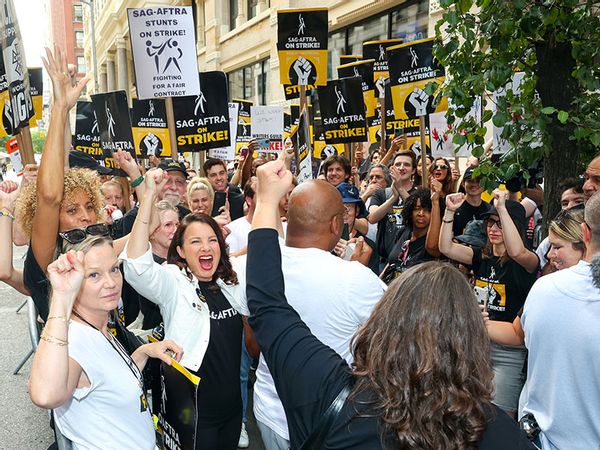 Fran Drescher is seen at the SAG-AFTRA picket line in Downtown, Manhattan on August 03, 2023 in New York City. (Jose Perez/Bauer-Griffin/GC Images/Getty Images)
Fran Drescher is seen at the SAG-AFTRA picket line in Downtown, Manhattan on August 03, 2023 in New York City. (Jose Perez/Bauer-Griffin/GC Images/Getty Images)On July 14, SAG-AFTRA members joined the writers, also striking after not being able to reach a deal with the AMPTP. Around 160,000 actors have taken to the picket lines, fighting for higher wages and protections against AI, and essentially shutting down Hollywood. Production across TV and film has been shut down, and you won't see any actors promoting their work until the strike ends either. Just imagine how glorious a "Bottoms" press tour would have been.
Nonetheless, both the actors and writers felt they had no choice but to strike after negotiations with the AMPTP broke down over issues as critical as addressing how the streaming model keeps them from making both a living wage and having health insurance and how they have little control over their own likeness due to rapid and recent developments in AI. Earlier this summer, SAG-AFTRA chief negotiator and national executive director Duncan Crabtree-Ireland told Salon Video what he thought the dual-strikes said about the moment. "Clearly, the AMPTP companies are not taking their responsibility seriously to find a path to an agreement with these unions," he said.
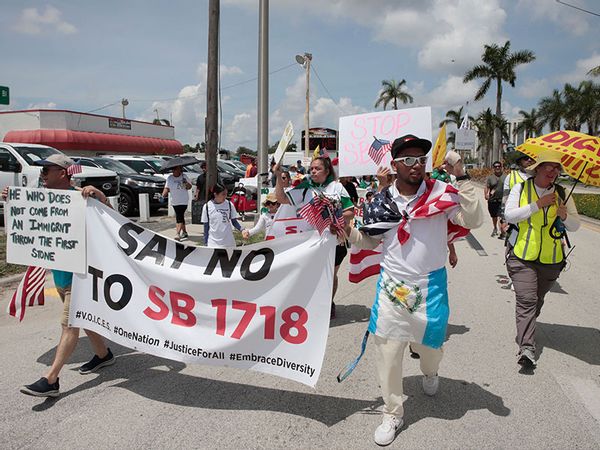 Protesters against a new immigration law march along Palm Beach Boulevard in Fort Myers, Florida, on June 28, 2023. (JOSEPH AGCAOILI/AFP via Getty Images)
Protesters against a new immigration law march along Palm Beach Boulevard in Fort Myers, Florida, on June 28, 2023. (JOSEPH AGCAOILI/AFP via Getty Images) Call Center Headset Device At Office Desk (Getty Images/Tashi-Delek)
Call Center Headset Device At Office Desk (Getty Images/Tashi-Delek)Approximately 200 call center workers across Virginia, Mississippi, Louisiana, Arizona and Florida went on a one-day strike in early June and August, picketing Maximus, the government's largest call center contractor. Communications Workers of America (CWA) members asked for $25 an hour, opportunities for career advancement, longer lunch and bathroom breaks, better COVID-19 protocols, and protection from layoffs. Just one month before the strike, 700 Maximus call center workers were laid off – the company's second round of layoffs this year. Some workers feel they were laid off for their organizing efforts, which include calling attention to the racial disparities at Maximus.
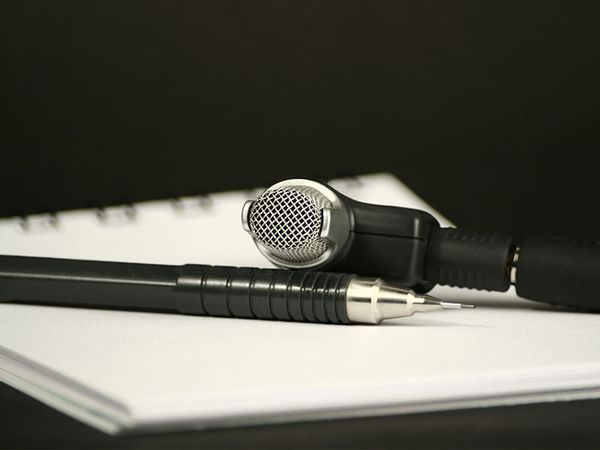 Microphone, pencil and note pad (Getty Images/Michal_edo)
Microphone, pencil and note pad (Getty Images/Michal_edo)Hundreds of journalists across eight states and 24 local newspapers staged a walkout on June 5 to protest budget cuts and the leadership at Gannett. The walkouts, which lasted for two days at some locations and one day at others, coincided with the company's annual shareholder meeting, where union members hoped shareholders would hold a vote of no confidence for CEO Mike Reed, who led the company through a 2019 merger that resulted in layoffs and the closing of newsrooms. The NewsGuild, which represents Gannett workers, says that the company's workforce has decreased by 47% in the past three years because of layoffs and other cost-cutting measures. Those on strike were also demanding an increase in base pay to $60,000 a year.
Separately but also within the media industry, Insider Union reached a tentative agreement with their management after a 13-day strike in mid-June, winning a $65,000 salary minimum, immediate raises for members, significant healthcare cost reimbursements and no layoffs through 2023. The approximately 250 union members made history by staging the longest digital media strike ever.
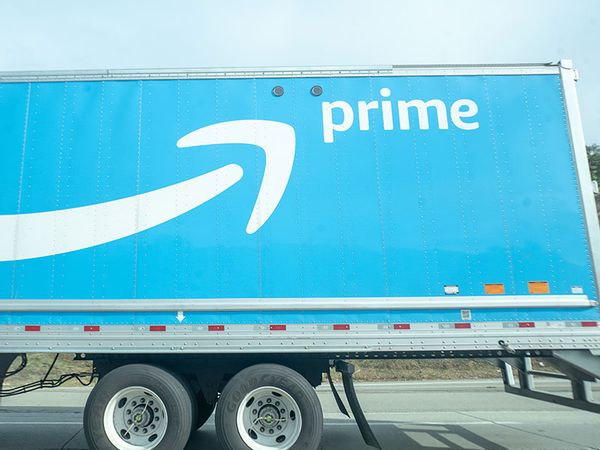
 View of rear section of Amazon Prime semi truck in California, December 12, 2019. (Smith Collection/Gado/Getty Images)
View of rear section of Amazon Prime semi truck in California, December 12, 2019. (Smith Collection/Gado/Getty Images)Starting in June, Amazon delivery drivers and dispatchers from California have joined forces with Teamsters to picket Amazon's unfair labor practices. In addition to demanding higher wages and safer working conditions, Palmdale organizers are fighting to get Amazon to recognize the Teamsters, respect their contract and reinstate unlawfully terminated employees. The 84 workers have picketed 10 Amazon warehouses across the country.
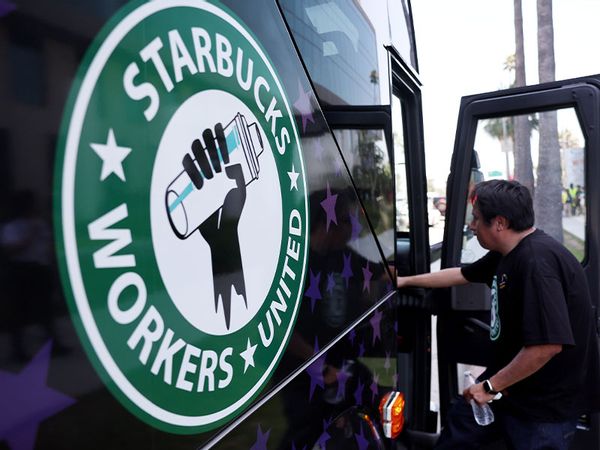 A Starbucks worker boards the Starbucks union bus outside Netflix studios on July 28, 2023 in Los Angeles, California. (Mario Tama/Getty Images)
A Starbucks worker boards the Starbucks union bus outside Netflix studios on July 28, 2023 in Los Angeles, California. (Mario Tama/Getty Images)In late June, around 3,000 Starbucks workers across over 150 stores striked after employees in 21 states reported they were not able to display Pride Month decorations (though the company says this is not part of their policy). Members of Starbucks Workers United (SWU), which consists of around 8,000 workers, participated in a staggered strike that lasted a week and began in the company's flagship store in Seattle.
Then, on Aug. 7, Starbucks workers initiated a "Day of Action" across the United States to call attention to the stores that are trying to unionize. Major issues the union is working for include higher pay, better benefits and more consistent staffing. In total, there were 17 additional strikes held at individual stores across the United States, in places like Oregon, Alabama, New York, Philadelphia, Iowa, California and New Jersey. Workers expressed concerns about their safety, union-busting and fighting for their first contract. Recently, the company's flagship store in Seattle, which the SWU says has experienced "massive union-busting," recently hosted Ed Sheeran for a shift, landing the singer in hot water.
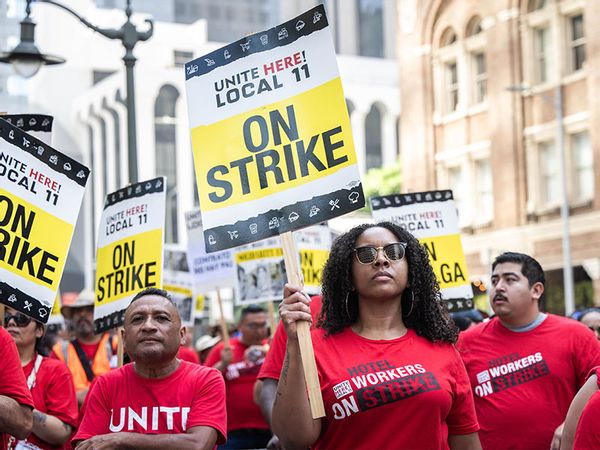
 Hotel workers outside InterContinental Los Angeles Downtown hotel on Monday, August 7, 2023 demand higher wages and better benefits. (Sarah Reingewirtz/MediaNews Group/Los Angeles Daily News via Getty Images)
Hotel workers outside InterContinental Los Angeles Downtown hotel on Monday, August 7, 2023 demand higher wages and better benefits. (Sarah Reingewirtz/MediaNews Group/Los Angeles Daily News via Getty Images)On July 2, about 15,000 UNITE HERE Local 11 members that work across 60 Southern California hotels began their strike, demanding higher wages to match the rising cost of living. Housekeepers, dishwashers and other hotel workers were negotiating for a $5 hourly wage boost that would ultimately increase to $11 by the end of a three-year contract in hopes to be able to live near where they work. Other issues include health care, health and safety on the job, securing full time positions for temporary workers and racial justice. They are also calling for a boycott of the hotels they're negotiating with, who they say have also been failing to hire more staff when necessary, resulting in unfair workloads.
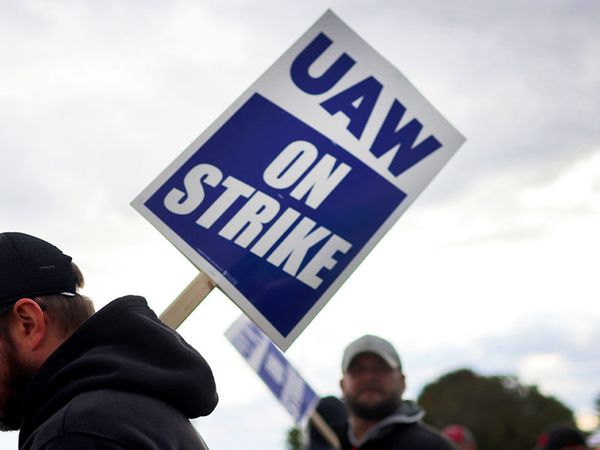 United Auto Workers (UAW) strike sign (Scott Olson/Getty Images)
United Auto Workers (UAW) strike sign (Scott Olson/Getty Images)On Aug. 1, 84 United Auto Worker factory workers in Newton, Iowa went on strike after their company refused to bargain until a week before their contract was about to expire. These workers, who help build polyurethane wheels for electric forklifts, were fighting for fair wages, a better work-life balance and to secure their Accident and Sickness benefits after the company attempted to weaken them.

 Los Angeles city workers gather at City Hall over unfair labor practice on August 8, 2023 in Los Angeles, California. (I RYU/VCG via Getty Images)
Los Angeles city workers gather at City Hall over unfair labor practice on August 8, 2023 in Los Angeles, California. (I RYU/VCG via Getty Images)On Aug. 8, over 11,000 SEIU Local 721 members went on a one-day strike, protesting exploitative working conditions and "bad faith" contract negotiations. The striking Los Angeles city workers shut down some public services for the day while they fought for issues like higher pay so that they could afford to live near where they work and better staffing, something that impacts their safety on the job. These sanitation workers, lifeguards, mechanics, airport custodians and more held dozens of picket lines across city landmarks.
 A row of parked school busses in a lot (Getty Images/Herman Bresser)
A row of parked school busses in a lot (Getty Images/Herman Bresser)Classes were canceled on Aug. 21 in East Baton Rouge Parish, when bus drivers and cafeteria workers pledged to call in sick that day over wage increases and short staffing. While the bus drivers are fighting for the increase, cafeteria workers called in sick in solidarity and encouraged teachers to join. On Friday of the previous week, about half of bus drivers had also called in sick to protest the one-year stipend they were given instead of a permanent pay raise.
 Robert Wood Johnson University Hospital in New Brunswick, New Jersey. (Bobby Bank/Getty Images)
Robert Wood Johnson University Hospital in New Brunswick, New Jersey. (Bobby Bank/Getty Images)Ever since the COVID-19 pandemic, we've come to understand the importance of nurses on a deeper level. Still, these essential, front-line workers do not have their needs met on the job. Across the United States, thousands of nurses have been striking this summer over issues that include short staffing, wages, hazard pay and health insurance, and there are still more to come. The Cedars-Sinai Marina del Rey recently issued a 10-day notice of a one-day strike. Below are some of the many nurse strikes from throughout the summer:
On June 17, 1,800 nurses at two Providence hospital locations in Oregon went on strike that lasted five days.
On June 27, registered nurses were on strike for one day at three Ascension hospitals in Texas and Kansas.
On July 11, nurses at Oahu Care Facility in Honolulu, Hawaii went on a seven-day strike.
On July 31, Loretto Hospital, an Austin, Chicago hospital that primarily serves low-income patients, ended in victory after an 11-day strike.
On Aug. 3, hundreds of nurses at Rochester General Hospital in New York went on strike for two days.
Since Aug. 4, approximately 1,700 nurses at the Robert Wood Johnson University Hospital in New Jersey have been on strike.
On Aug. 5, dozens of hospital workers at Trinity Grand Haven Hospital in Michigan went on a one-day strike.
In Monterey Park, California, nurses at Garfield Medical Center went on strike for 10 days in mid-August.
Over 500 nurses at Ascension St. Joseph Hospital, Joilet, Illinois' only hospital, went on strike in late August after working without a contract since May.
On Aug. 29, hundreds of nurses at St. Francis Medical Center in Lynwood, California went on strike for one day.
Want a daily wrap-up of all the news and commentary Salon has to offer? Subscribe to our morning newsletter, Crash Course.
Read more
about this topic
- Sit-down strikes revolutionized the labor movement — could it happen again?
- Amid growing hunger, Americans turn to fast-food joints — whose workers say they can't afford to eat
- Both sides do it — wage relentless war against the working class, that is
- Federal judge says AI-generated art can't be copyrighted in ruling that may impact Hollywood studios


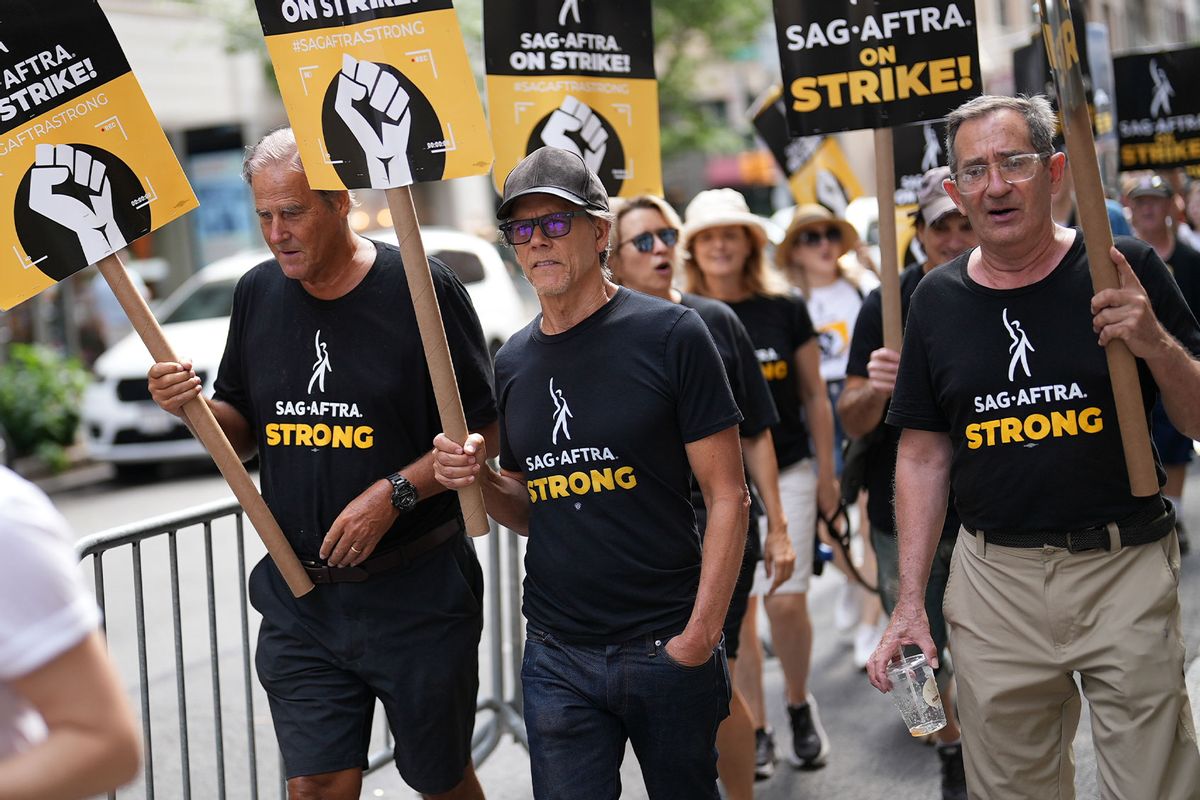
Shares